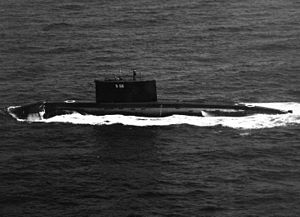INS Sindhughosh (S55)

| |
| History | |
|---|---|
| Name | INS Sindhughosh |
| Namesake | "Sea - Battle Cry" |
| Launched | 29 June 1985 |
| Commissioned | 30 April 1986 |
| Status | in active service |
| General characteristics | |
| Class and type | Sindhughosh-class submarine |
| Displacement |
|
| Length | 72.6 m (238 ft) |
| Beam | 9.9 m (32 ft) |
| Draught | 6.6 m (22 ft) |
| Propulsion |
|
| Speed | |
| Range |
|
| Endurance | Up to 45 days with a crew of 52 |
| Test depth |
|
| Complement | 52 (incl. 13 Officers) |
| Armament |
|
INS Sindhughosh (S55) is the lead ship of her class of diesel-electric submarines of the Indian Navy.[3]
The submarine was commissioned on 30 April 1986 in Riga, Latvia under the command of Commander K C Varghese.[4] The submarine is diesel-powered and has a total of six motors. INS Sindhughosh was the first submarine in Indian Navy to be equipped with the Klub ZM-54E SS-N-27 antiship cruise missiles with a range of 220 kilometres (140 mi). The submarine has a displacement of nearly 3,100 tons when submerged, a maximum diving depth of 300 metres (980 ft), speed of up to 17 knots (31 km/h), and is able to operate solo for 45 days with a crew of 52.
Service history
Collision with a foreign vessel (2008)
INS Sindhughosh collided with a foreign merchant vessel - MV Leeds Castle - while trying to surface in the seas north of
Fire damage (2013)
On 14 August 2013, Sindhughosh sustained minor damage in a fire which caused explosions and the sinking of INS Sindhurakshak, while at dock in Mumbai. The navy did not release any details of the extent of damage on Sindhughosh.[5]
Runs aground (2014)
On 17 January 2014, INS Sindhughosh ran aground due to the low tide, while returning to Naval Dockyard, Mumbai.[6]
References
- ^ "Rosoboron exports - Project 636".
- ^ "Rosoboron exports - Project 636".
- ^ "Submarines of Indian Navy". Archived from the original on 19 June 2009. Retrieved 5 August 2009.
- ^ "SpokespersonNavy on Twitter". Twitter. Retrieved 23 May 2017.
- ^ "International help to salvage sunken submarine". Business Standard. 20 August 2013. Retrieved 20 August 2013.
- ^ "Submarine hits ground due to low tide, no casualty". Mumbai Mirror. 19 January 2014. Retrieved 6 July 2019.
External links

